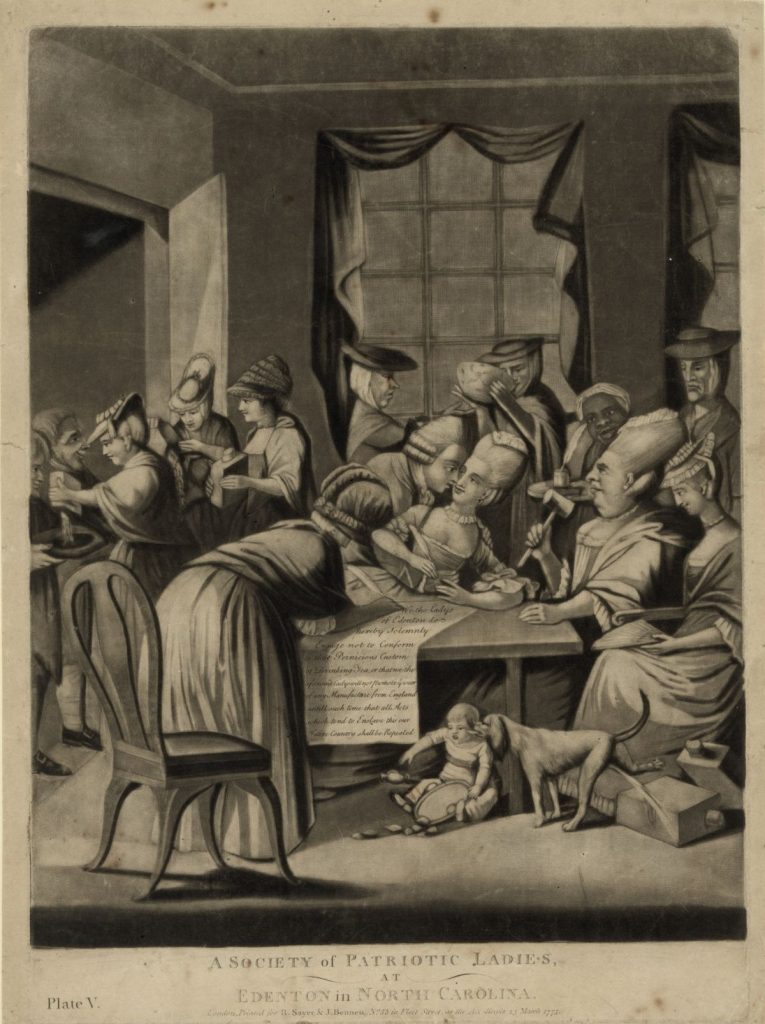Background
The events of the American Revolution took place just when political cartoons became very popular in England. People gathered every day at print shops all over London to learn the news and see the latest cartoons mocking the events of the day. Politicians quickly learned the power of a good cartoon. There is even evidence that some English politicians hired artists to mock their enemies and improve their own standing.
About the Image
These two cartoons show how women were portrayed in political cartoons about the American Revolution. “A society of patriotic ladies, at Edenton in North Carolina” is a cartoon about a real event. The women in the cartoon are ugly, immoral, and neglectful of their duties as wives and mothers. The artist drew them this way because he thought it was unnatural for women to speak publicly about their political opinions. The cartoon also mocks the British government by showing that they have managed the colonies so badly that even women feel like they can openly rebel.
The cartoon “Bunkers Hill or America’s head dress” does not show a real woman. Instead, it uses the figure of a woman to make a larger point. The woman’s extreme hair style makes fun of the extravagant fashions popular with upper-class English women. The Battle of Bunker Hill staged in the hairdo mocks how much trouble the rebellion in America was causing the British government. This cartoon was produced by a husband and wife team of engravers and caricaturists, Matthew and Mary Darly. Mary was a master caricaturist who wrote the book on drawing funny caricatures, A book of Caricaturas with ye Principles of Designing in ye Droll and Pleasing Manner, in 1762.
Vocabulary
- Battle of Bunker Hill: An American Revolution battle that took place during the Siege of Boston on June 17, 1775.
- caricature: An exaggerated drawing meant to make something or someone look ridiculous.
- engraver: A person who makes printed images from metal plates.
Discussion Questions
- How do women appear in English political cartoons?
- What do these cartoons reveal about English attitudes about the war in America?
- What do these cartoons reveal about English attitudes toward women?
Suggested Activities
- APUSH Connection: 2.7: Colonial Society and Culture
- Combine “A society of patriotic ladies” with the Edenton Tea Party statement for a lesson about women’s political action and public response.
- Teach this object together with any of the following for a lesson on the many ways women expressed their political opinions during the American Revolution, and how their actions were received: Spinning Wheels, Spinning Bees, A Call to Arms, The Edenton Tea Party, Sentiments of an American Woman, and Abolition and Revolution.
- Deconstruct the images with your students by cutting them up and writing explanations of significant details.
- Compare these cartoons with modern-day political cartoons and investigate how the practice has evolved over time.
- Challenge students to make their own political cartoon in support of women’s activism during the American Revolution.
- Invite students to study samples from Mary Daly’s A book of Caricaturas with ye Principles of Designing in ye Droll and Pleasing Manner, and devise their own eighteenth-century style caricatures lampooning figures of the American Revolution.
Themes
POWER AND POLITICS; ACTIVISM AND SOCIAL CHANGE
New-York Historical Society Curriculum Library Connections
- For resources relating to the American Revolution in New York, see The Battle of Brooklyn.








